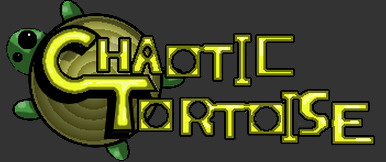Chaotic Tortoise Studios (CTS) is an indie games development studio that exists largely only in my mind.
I like this sprite. This sprite is not a problem. I will probably post this sprite a lot because I like this sprite.
I’ve always appreciated that to make a video game it takes a lot of work and mastery of several different disciplines. Despite this, I’ve discovered that I never actually really appreciated just how much of this work and mastery goes in to making even the crummiest of games. Never again will I outright dismiss a title as bad or worthless without first spending a bit of time checking the small minor details that I have overlooked.
I know that most games are made by more than one person (and technically one of mine is now a two-person-project because my flatmate spontaneously started constructing some amazing chip-tune-inspired music for one of my projects) which can dilute the amount of work that is needed from the individual, but even with a whole team working on specific areas, the sheer level of time and effort that goes into something simple is staggering.
I’ve been working on my top-down-maze-puzzler-with-potentially-pretentious-undertones (your standard TDMPWPPU), Ego, and another game involving a Ninja. In short, I’ve been struggling with backgrounds and incidental graphics. I’m proud of some of my sprites, but all of the little background textures, walls, floors, and general doodads I lose focus on or try to rush and generally speaking mess up. These are the things that, if you’ve done your job well, no one will ever notice them and they will only ever stand out to your average player if they look bad. It is unbelievably frustrating to work hard on something just to get it to “unremarkable”.
I really need to look to more examples of where this sort of thing works well. I’ve been looking a little closer at the textures and wall decals in Super Meat Boy (Chaotic Tortoise Game / Catalyst in Controller Flinging of the year 2010) and they’re uniformly simple and highly effective, remaining consistent with the style and tone of the piece without ever jumping out and screaming “LOOK AT ME I’M A GRAPHIC!” like all good game-scenery should.
I’ve actually currently got a method whereby I don’t need to tile things and can just paint over a level layout which is great for the image creation (although frustrating if I need to edit the level afterwards, so this sort of graphical work has to take place RIGHT AT THE END of the process) as it means I’ll avoid turning my carefully honed textures into something that looks like a magic-eye picture, but I’ve found myself utterly stumped as to what I should construct. I wonder if this is a problem endemic to my art in particular. With my comics, I, like a lot of fledgling comic book artists, have always suffered with a complete lack of decent backgrounds and this may be starting to bleed into my efforts with game creation.
A revelation that I have made over the last few days is that this is much more of an art form than I had given it credit. For me, this renders the whole “are video games art?” argument moot. If the finished product is not art, then the video game is still some a towering construct built from raw art itself.
Additional Notes:
When you start making games, you get a visit from a man in a black suit and blue tinted sunglasses who tells you that you have to make games about ninjas or zombies as these are the designated zeitgeist themes right now, and I’m not a massive fan of zombies. Apparently he used to say that you could only make games about Space Marines in Space, so at least there are more options today. I was amazed that none of the Game Maker tutorials that I read through warned me about this.
